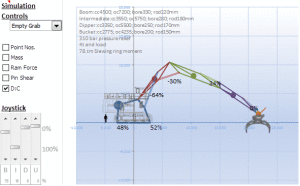Like a child selecting parts to construct a Lego model engineers bring together blocks of science to create new designs. These building blocks could be a load calculation, a beam calculation, a weld calculation, a fatigue calculation or any other calculation from a myriad of engineering topics. As individuals we are unlikely to be an expert in all topics and (just like a Lego model) if one block is missing the whole construction comes to a halt. Search the ExcelCalcs Repository to find your missing (or damaged) pieces of expert knowledge - where it's available in Excel format 24 hours a day.

“We need to build one of the world's largest excavators within 3 months!” exclaimed our Australian client. Signing up for the challenge ExcelCalcs promised a five week turn around for structural design. Our Lego-like approach to engineering was the only way to meet the tight timescales. The job started by setting the engineering goals in the form of a Structural Performance Specification. This defined proof loadcases which must not result in any permanent deformation or gross material yield and a safety factor of 1.5 against buckling. It is necessary to demonstrate that the most onerous load configurations have been considered. The structure must also support all published lift capacity figures with stresses that do not exceed material yield and incorporate an adequate factor of safety. The cyclic nature of machine operation gives rise to stress cycles that can initiate and propagate cracks leading to fatigue failure. The welded construction of the excavator makes it sensitive to this form of failure. The most critical areas of the excavator will be poor weld details in highly stressed parts of the structure. The design must ensure that these features will not fail during the design life of the vehicle. The fatigue loadcases are defined by operational cycles made up from discrete loadcases. The stresses calculated by finite element analysis for each discrete loadcase are processed using a rainflow algorithm and evaluated against the fatigue S/N curves.

The animated chart shows a 2D spreadsheet we developed to assess any machine configuration positioning the arm using Excel slider controls. Assessment was made easy by displaying all results of hydraulic capacity calculations and stability calculations on a single interactive chart. The 2D spreadsheet also produced an ANSYS script to automatically generate a 3D finite element model for a detailed assessment of any machine configuration. Using strength and fatigue calculators downloaded from the ExcelCalcs site the design was completed on time and it outperforms its requirements set in the Structural Performance Specification. The triple arm excavator is currently under construction its enormity dwarfs construction workers (almost a 30m reach).
How to take advantage of ExcelCalcs:
1. Sign up for a subscription (free trials, educational and professional subscriptions available).
2. Sign up an ExcelCalcs consultant to participate in your own engineering projects.
3. Host an in-house ExcelCalcs training event.
4. Set up own ExcelCalcs facility on your company server.
